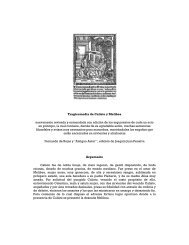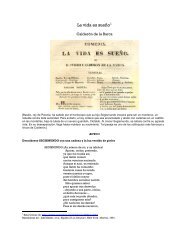Create successful ePaper yourself
Turn your PDF publications into a flip-book with our unique Google optimized e-Paper software.
GOING TO HELL IS HELL:<br />
THE MOST TERRIFYING SCENE IN OPERA<br />
Hell has often been presented on the stage. The<br />
medieval theatre was rife with “hell mouths”:<br />
colorful, flame-filled openings teeming with demons<br />
that had firecrackers exploding out of their rears.<br />
However, the hell of <strong>Don</strong> <strong>Giovanni</strong> is a special kind<br />
of hell, a hell without parallel because of the terror of<br />
its music. Writing about it cannot begin to summon<br />
its grandeur; I include it here only to direct you to it<br />
for listening purposes. It begins, really, in the<br />
previous scene in the cemetery when the <strong>Don</strong><br />
impiously invites the statue of the Commendatore to dinner. (He actually forces the<br />
terrified Leporello to do it.)<br />
But the real terror begins with the entrance of the Commendatore with an earth-shattering<br />
diminished seventh chord in the brass followed by the lines “<strong>Don</strong> <strong>Giovanni</strong>! A cenar teco<br />
m’invitasti, e son venuto” – <strong>Don</strong> <strong>Giovanni</strong>, you invited me to supper, and I’ve come as<br />
your guest. The <strong>Don</strong> is at first polite, as their measured exchange is punctuated by<br />
Leporello’s frantic asides, but the Commendatore is persistent, telling him to repent. The<br />
repeated command “Pentiti!,” Repent!, is ignored by the <strong>Don</strong>, with repeated “No!s” With<br />
each exchange the level of tension rises. The <strong>Don</strong>, who refuses to repent and claims he<br />
has no fear, offers his hand to the Commendatore, at which point the floor opens up and<br />
the <strong>Don</strong> is engulfed by the licking flames of hell, which have been musically rising up<br />
throughout the scene. Da Ponte’s stage directions actually read “He is swallowed up by<br />
the earth.” This scene is vividly brought to life in the film Amadeus using a carefully<br />
researched recreation of the staging conventions of Mozart’s day.<br />
OMISSION OF THE FINAL ENSEMBLE<br />
This harrowing scene is followed by a ridiculous major key ensemble during which all<br />
the characters appear and sing “Such is the end of all wrongdoers! The death of those<br />
who betray us is worthy of the life they lead.”<br />
Hmmm.<br />
When <strong>Don</strong> <strong>Giovanni</strong> was presented in Vienna shortly after its premiere in Prague this<br />
ending was cut. In fact, it was generally omitted until the mid-twentieth century. Without<br />
this jaunty ending it would seem to be a tragedy. With it, it has a “happy ending” in<br />
which wrong is punished, which would make it a comedy. So is it a tragedy or a comedy?<br />
YOU get to decide!<br />
Dayton Opera <strong>Ultimate</strong> <strong>Study</strong> <strong>Guide</strong> 10 <strong>Don</strong> <strong>Giovanni</strong>





